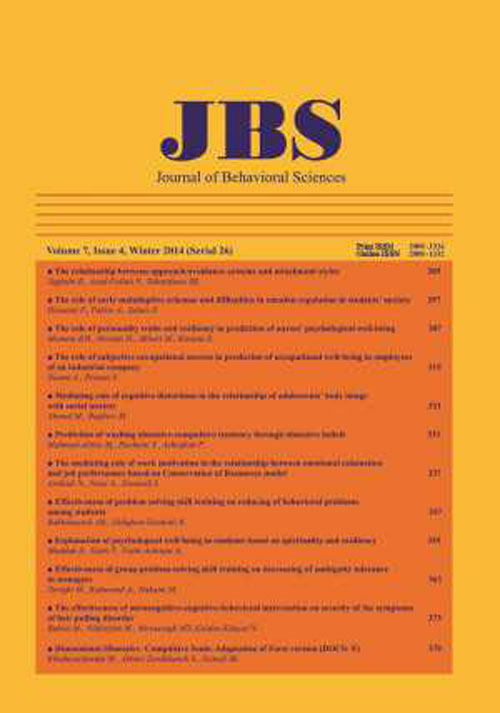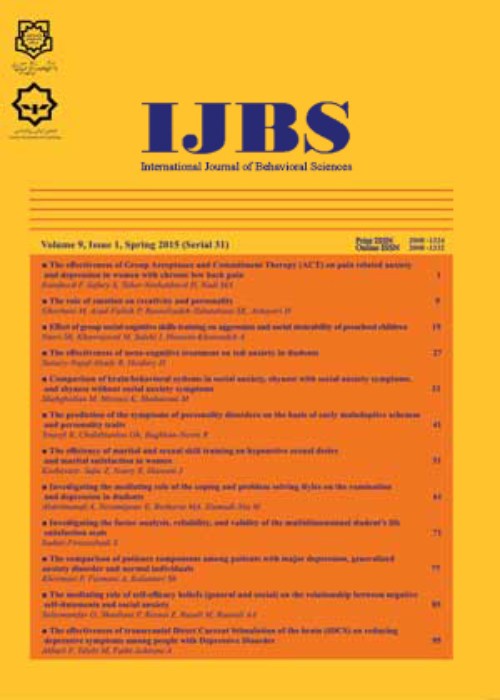فهرست مطالب

International Journal of Behavioral Sciences
Volume:10 Issue: 2, Spring 2016
- تاریخ انتشار: 1395/04/04
- تعداد عناوین: 6
-
-
Pages 49-54IntroductionThis study aims to compare the cognitive performance of patients with Multiple Sclerosis (MS) in the field of autobiographical, prospective and working memory compared to normal people.MethodIn a causal-comparative study using convenience sampling 200 patients with MS (100 were affected less and 100 were affected more than 2 years (and 100 healthy individuals were matched regarding their age, sex, education level and economic conditions. Research tools included Autobiographical Memory Interviews (AMI), Autobiographical Memory Test (AMT), questionnaire of Prospective Oriented Memory (POM) and the information processing index. The obtained data were analyzed using MANOVA and Bonferroni post hoc test.ResultsThe results showed that in all three areas of working, autobiographical and prospective memory there is a significant difference between MS patients (groups affected more and less than 2 years) and the normal group. This reflects the poor performance of MS patients in the three working, autobiographical and prospective memory compared to the normal group.ConclusionAccording to the findings, it seems that the MS disease can damage cognitive performance. Providing cognitive rehabilitation exercises in order to improve cognitive performance and processing speed in these patients is debatable.Keywords: Multiple Sclerosis, Autobiographical Memory, Working Memory, Prospective Memory
-
Pages 55-59IntroductionSelf-care is an important process in the control of chronic diseases especially epilepsy. The aim of this study was to investigate the self-care situation and the affecting factors on it in patients with epilepsy living in Isfahan.MethodIn this sectional study, 320 patients were chosen with large seizures clientele by simple random sampling from hospitals (Hospitals that accept patients with epilepsy), neurologistsclinics, and epilepsy associations in Isfahan. The inclusion criteria in this study was comprised of epileptic patients living in Isfahan and its suburbs, having a medical record, at least one year history of the disease, and the patient's willingness to participate in the study. The data collection tools was a researcher questionnaire (validity and reliability of the tool was approved by experts in this issue and its Cronbach's alpha coefficient was estimated to be 0.80). This questionnaire evaluated the self-care status and the influencing factors on it in patients. Data were analyzed by using independent t-test and a one way variance analysis were analyzed.ResultsThe average scores for self-care in patients (0.39±13.26) and self-care situation was undesirable. Knowledge of the disease with average (4.34±12.86) was desirable but skill (0.8±8.24) and ability (10.70±25.98) were undesirable and half favorable. Self-care scores based on age, sex, education and marital status did not differ significantly. Regression analyses revealed that self-care behaviors and a total of 21% of behavior variance was predictable.ConclusionIn order to improve the health of patients with epilepsy and appropriate disease control,teaching programs with the aim of empowering patients in the field of self-care should be considered. Patients with higher education and those who are symptomatic, may be more likely to engage in self-care than those who are poorly educated or asymptomatic. Epilepsy self-care is both a process and a set of behaviors that helps people care about their epilepsy. Self-care encompasses the process and the behaviors needed to manage a wide range of skills.Keywords: Self, Care, Epilepsy, Isfahan
-
Pages 60-65IntroductionEmotion Regulation Therapy (ERT) is an in-progress treatment developed for Generalized Anxiety Disorder (GAD) comorbid with Major Depressive Disorder (MDD) based on ameliorating dysfunctions in emotion regulation strategies. However, ERT is a newly evolved treatment and has not yet been examined among Iranian samples. Therefore, the aim of the present study was to evaluate the efficacy of ERT for the comorbid condition.MethodTreatment efficacy was assessed using single case methodology in one referred individual suffering from GAD and comorbid MDD.ResultsThe subject showed decreases in anxiety and depression scores and increased scores in attending, allowance, decentering and reframing emotion regulations.ConclusionEmotion regulation therapy can be an efficient treatment for GAD comorbid with MDD.Keywords: Emotion Regulation Therapy, Comorbidity, Anxiety, Depression
-
Pages 66-71IntroductionThis research was conducted with the goal of determining the effectiveness of training the McMaster Model on mindfulness and marital conflicts of couples.MethodIn this quasi-experimental method, among those couples who had referred to Iran Social Work Clinic due to marital conflicts during 2014 (70 couples), 20 couples who met the requirements were selected as the research sample on a randomly substitution basis and were placed in two groups (test and witness). The experimental group was trained under the McMaster training model during 10 sessions each 90-120 minutes. The Five-Facet Mindfulness Questionnaire (FFMQ) scale and Marital Conflicts Questionnaire (MCQ) were used as the research tool in three stages, namely pretest, posttest and follow-up.ResultsThe findings of this research showed that there is a significant difference between the marks of test and control groups in immediacy and marital conflicts as compared to control group; i.e., training the McMaster model has increased mindfulness and decreased marital conflicts between the couples and this effect is durable over time.ConclusionTherefore, considering the research findings, it can be concluded that McMaster modelc an be used as an intervention method by couple therapists and family therapists.Keywords: McMaster Model, Mindfulness, Marital Conflicts
-
Pages 72-76IntroductionSimilar to social and conscious emotions, shame and guilt have gained increasing attention because of their eminent emotional, motivational, and cognitive functions that ultimately guide human being's perception and behavior. The aim of this study was to assess the relationship between shame and guilt feelings with the dimensions of loneliness (familial, social, and romantic).MethodsFor conducting this study, 398 grade 12 high school students (218 girls and 180 boys) were selected using the randomized multistage cluster sampling method in Shiraz. Cohen's Guilt and Shame Proneness Scale and the Social-Emotional Loneliness Scale for Adults (Short Form) were used for data collection. The validity and reliability of the measures were evaluated.ResultsResults revealed that guilt feeling could positively predict familial, social, and romantic loneliness. Moreover, guilt could negatively predict social and familial loneliness. Furthermore it was observed that gender had a mediating effect on the studied relationships. By comparing both genders the results obtained by the girls were congruent with the total score while the results were different regarding the boys.ConclusionConclusively, we found that shame and guilt feelings predict the dimensions of loneliness differently and thus this study provides evidence in line with differentiating the effects of these feelings.Keywords: Shame, Guilt, Familial Loneliness, Social Loneliness, Romantic Loneliness
-
Pages 77-83IntroductionThe aim of the current study was to investigate positive thinking in Islamic spirituality and to develop a theoretical model based on Islamic view.MethodsThe research method in this study was based on qualitative approach. The study used a content analysis design with a hermeneutic approach to collect and analyze the data. In order to do so, sacred texts especially holy texts (i.e. Quran and Ahl al-Bayt''s performance and oral tradition) were reviewed through hermeneutic understanding.ResultsFindings demonstrated that positive psychology in Islamic spirituality mostly centers on the following topics: Islamic positive view of human, believing in Divine benevolence, gratitude, Tawakkul, and universal man. Also, based on the attachment theory, positive thinking was interpreted and its applications were explained for individual''s thinking about past events, interpretations of present events, and future expectations. Positive thinking in this paradigm was discussed in a way that included individual''s relationship with transcendental beings, others, nature, and self.ConclusionThe Islamic approach is very optimistic about human nature and its capacity for growth. It is also optimistic about the relation of human beings with God. The fourfold relational paradigm of positive thinking in Islamic spirituality has been accepted as a base for all relations. Approaching this paradigm and orienting thoughts, feelings, and actions towards this view may be achieved through an ontological gnostic worldview.Keywords: Attachment, Fitrah, Islam, Positive Thinking, Model


